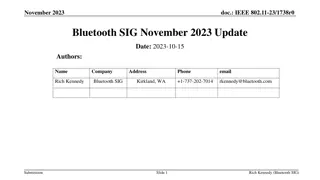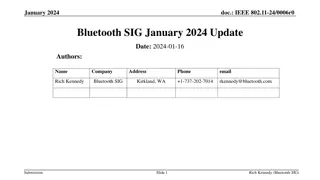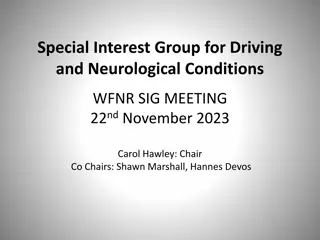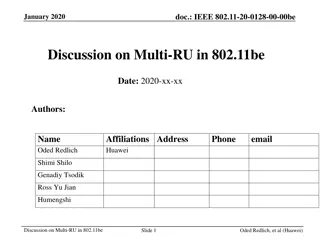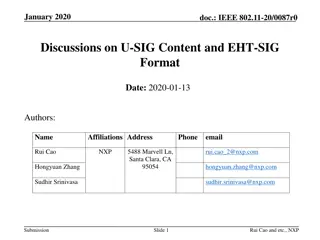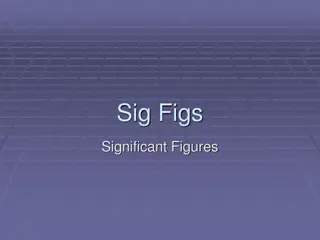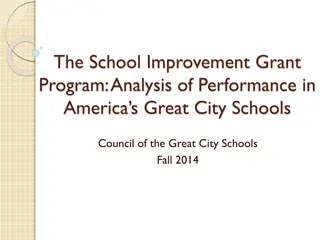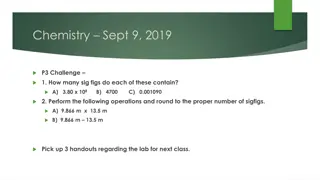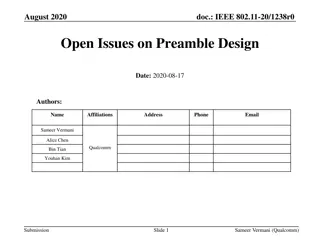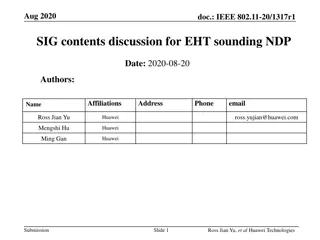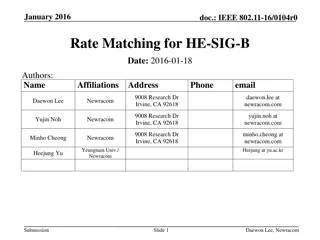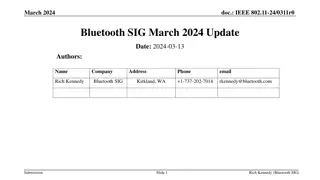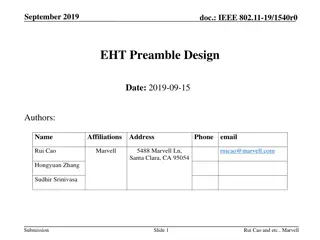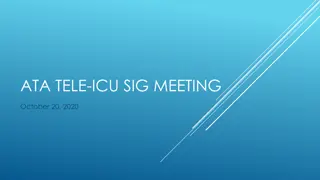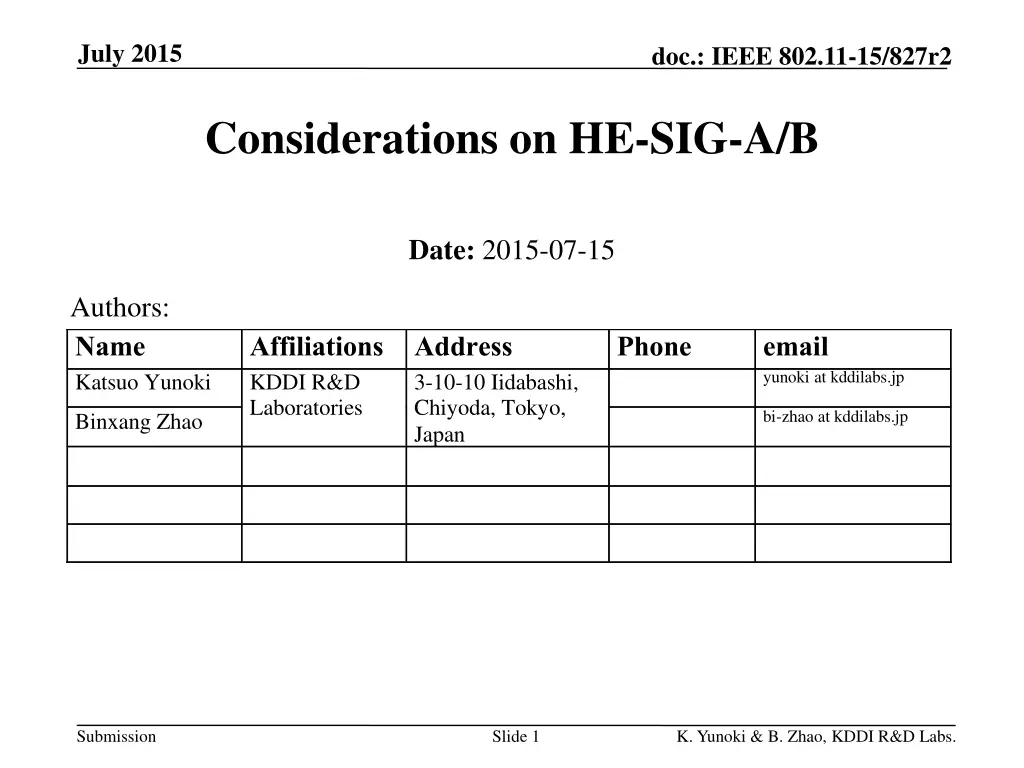
IEEE 802.11-15/827r2 HE-SIG-A/B Considerations and Configurations
Explore the considerations and possible configurations of HE-SIG-A/B for DL-OFDMA in IEEE 802.11-15/827r2. This submission discusses MCS per OFDMA resource unit, expression of HE-SIG-B, and various possible configurations of HE-SIG-B, including duplicates per 20MHz and non-duplicated options. Dive into the required OFDM symbols for HE-SIG-B as detailed in the document.
Download Presentation

Please find below an Image/Link to download the presentation.
The content on the website is provided AS IS for your information and personal use only. It may not be sold, licensed, or shared on other websites without obtaining consent from the author. If you encounter any issues during the download, it is possible that the publisher has removed the file from their server.
You are allowed to download the files provided on this website for personal or commercial use, subject to the condition that they are used lawfully. All files are the property of their respective owners.
The content on the website is provided AS IS for your information and personal use only. It may not be sold, licensed, or shared on other websites without obtaining consent from the author.
E N D
Presentation Transcript
July 2015 doc.: IEEE 802.11-15/827r2 Considerations on HE-SIG-A/B Date: 2015-07-15 Authors: Name Katsuo Yunoki Affiliations Address KDDI R&D Laboratories Phone email yunoki at kddilabs.jp 3-10-10 Iidabashi, Chiyoda, Tokyo, Japan bi-zhao at kddilabs.jp Binxang Zhao Submission Slide 1 K. Yunoki & B. Zhao, KDDI R&D Labs.
July 2015 doc.: IEEE 802.11-15/827r2 Abstract This submission shows the following considerations on HE-SIG-A and HE-SIG-B for DL-OFDMA: #1 Possible contents for HE-SIG-B #2 HE-SIG-B configurations #3 Possible decoding optimization Submission Slide 2 K. Yunoki & B. Zhao, KDDI R&D Labs.
July 2015 doc.: IEEE 802.11-15/827r2 Consideration #1: MCS per OFDMA Resource Unit We agreed some patterns for OFDMA building blocks at May 2015 meeting. [2] It is preferable for each resource unit to use different MCS for better efficiency. Combination of resource units also should be identified for each transmission. e.g. Combination of resource units 16 OFDMA assignments in 80MHz BSS (ref: slide 30 of 15/330r5) Proposal #1: Resource unit assignment and MCS for respective resource unit will be contents in HE-SIG-B. K. Yunoki & B. Zhao, KDDI R&D Labs. Submission Slide 3
July 2015 doc.: IEEE 802.11-15/827r2 Consideration #1: e.g. Expression of HE-SIG-B RU = Resource Unit . RU Info #1 RU Info #2 RU Info #n RU QTTY Bits: 8 8 8 8 RU width: 0: SU 1: 26 tones 2: 52 tones 3: 106 tones 4: 242 tones 5: 484 tones MCS: MCS index for 11ac are 0~9. RU width 3 MCS 1 Bits: 4 reserved 4 bits will be enough. This is just an example. It can be optimized more. It can be expressed in 3 bits. Submission Slide 4 K. Yunoki & B. Zhao, KDDI R&D Labs.
July 2015 doc.: IEEE 802.11-15/827r2 Consideration #2: Possible Configurations of HE-SIG-B [3][4] Option-A. Duplicated HE-SIG-B per 20MHz Option-B. Non-duplicated HE-SIG-B per 20MHz variable variable [5] HE- SIG-B 1 Primary 20MHz HE- SIG-A HE- SIG-B HE- SIG-A Primary 20MHz L-Part L-Part Dup. HE- SIG-A Dup. HE- SIG-B Dup. HE- SIG-A HE- SIG-B 2 Dup. L-Part Dup. L-Part ... ... Dup. HE- SIG-A Dup. HE- SIG-B Dup. HE- SIG-A HE- SIG-B 3 Dup. L-Part Dup. L-Part Dup. HE- SIG-A Dup. HE- SIG-B Dup. HE- SIG-A HE- SIG-B 4 Dup. L-Part Dup. L-Part Option-D. HE-SIG-B per resource unit Option-C. Entire-channel HE-SIG-B frequency variable 16 s per OFDM Symbol 4 s per OFDM Symbol HE- SIG-A Primary 20MHz L-Part HE- SIG-A HE-SIG-B HE-SIG-B 10MHz 10MHz Dup. HE- SIG-A Dup. L-Part HE- SIG-A HE- SIG-B 20MHz ... HE-SIG-B Dup. HE- SIG-A Dup. L-Part time HE-SIG-A needs to have segment information of resource units. It s not feasible. That big information will not fit in HE-SIG-A. Dup. HE- SIG-A Dup. L-Part K. Yunoki & B. Zhao, KDDI R&D Labs. Submission Slide 5
July 2015 doc.: IEEE 802.11-15/827r2 Consideration #2: RequiredOFDM Symbols Required OFDM symbols for HE-SIG-B (64FFT) * A B 4 4 7 4 13 4 * 25 4 * Max. size of HE-SIG-B (required bits) Max. QTTY of RU BW C 4 4 4 4 20M 40M 80M 160M 9 18 37 74 80 152 304 600 Note-1) HE-SIG-B structure on Slide-4 is assumed. Note-2) 48 available subcarriers and coding rate = 1/2 are assumed per 20MHz. * It s subject how to express the resource units across two 20MHz. (next slide) Option-Aisn t efficient. It may not be practical. Proposal #2: HE-SIG-B should not be duplicated in every 20MHz as Option-A. K. Yunoki & B. Zhao, KDDI R&D Labs. Submission Slide 6
July 2015 doc.: IEEE 802.11-15/827r2 Consideration #2: An Issue on Option-B Some resource units are across two 20MHz sub-bands. How can we express these resource units in Option-B case?? Submission Slide 7 K. Yunoki & B. Zhao, KDDI R&D Labs.
July 2015 doc.: IEEE 802.11-15/827r2 Consideration #3: Decoding Issue for DL-OFDMA?? Definitive destination address will be acquired from decoded MAC frame. A receiving STA has to decode all resource units to pick up a desired MAC frame. : Minimum required portion for decoding Option-B. Option-C. HE- SIG-B 1 Primary 20MHz HE- SIG-A HE- SIG-A Primary 20MHz L-Part L-Part Dup. HE- SIG-A Dup. HE- SIG-A HE- SIG-B 2 Dup. L-Part Dup. L-Part HE- SIG-B ... ... Dup. HE- SIG-A HE- SIG-B 3 Dup. HE- SIG-A Dup. L-Part Dup. L-Part Dup. HE- SIG-A HE- SIG-B 4 Dup. HE- SIG-A Dup. L-Part Dup. L-Part It may be complicated for a receiving STA to decode the entire DL-OFDMA frame of multi-resource units with various MCSs and resource segmentations. K. Yunoki & B. Zhao, KDDI R&D Labs. Submission Slide 8
July 2015 doc.: IEEE 802.11-15/827r2 Consideration #3: Possible Optimization for Decoding Schemes When HE-SIG-A has an indication for sub-band selection, a receiving STA may be able to limit decoding portion just for a specific 20MHz. That indication will be with Multi-Access (MA) group ID. (Need further studies) Figures below are examples that are indicated in HE-SIG-A as 2nd 20M to be decoded. Doc. 15/821r0 : Minimum required portion for decoding Option-B. Option-C. Not well- optimized A kind of group ID in common field Indication for sub-band selection HE- SIG-B 1 HE- SIG-B 1 Primary 20MHz HE- SIG-A Primary 20MHz HE- SIG-A HE- SIG-A Primary 20MHz L-Part L-Part L-Part Dup. HE- SIG-A HE- SIG-B 2 Dup. HE- SIG-A HE- SIG-B 2 Dup. HE- SIG-A Dup. L-Part Dup. L-Part Dup. L-Part HE- SIG-B ... ... ... Dup. HE- SIG-A HE- SIG-B 3 Dup. HE- SIG-A HE- SIG-B 3 Dup. HE- SIG-A Dup. L-Part Dup. L-Part Dup. L-Part Dup. HE- SIG-A HE- SIG-B 4 Dup. HE- SIG-A HE- SIG-B 4 Dup. HE- SIG-A Dup. L-Part Dup. L-Part Dup. L-Part This optimization may reduce required processing power to decode DL-OFDMA frame on a receiving STA. K. Yunoki & B. Zhao, KDDI R&D Labs. Submission Slide 9
July 2015 doc.: IEEE 802.11-15/827r2 Consideration #3: Issues MAGroup Indication: How to make up the group for each sub-band? Resource units across two 20MHz sub-bands: The same issue as Slide-7 Channel estimation Maybe HE-LTF/STF will help it. Others? Submission Slide 10 K. Yunoki & B. Zhao, KDDI R&D Labs.
July 2015 doc.: IEEE 802.11-15/827r2 Conclusion Some contents of HE-SIG-B are proposed for DL- OFDMA PPDU. - Resource unit assignment (e.g. RU QTTY,RU width) - MCS per RU HE-SIG-B should not be duplicated on every 20MHz sub-band for better efficiency. Sub-band selection measure was proposed as a potential optimization. It may possibly reduce required processing power to decode DL-OFDMA PPDU on a receiving STA. K. Yunoki & B. Zhao, KDDI R&D Labs. Submission Slide 11
July 2015 doc.: IEEE 802.11-15/827r2 Straw Poll #1 Do you agree to add the following text into 11ax SFD? 3.2.3 HE-SIG-B HE-SIG-B includes resource unit assignment and MCS per resource unit for DL-OFDMA PPDU. Y/N/A = K. Yunoki & B. Zhao, KDDI R&D Labs. Submission Slide 12
July 2015 doc.: IEEE 802.11-15/827r2 Straw Poll 2 Do you agree to add the following text into 11ax SFD? 3.2 HE preamble 3.2.1 General Sub-band selection measure is provided in HE-SIG-A or HE- SIG-B for DL-OFDMA PPDU reception. Note: It is necessary to study appropriate position of that information. Y/N/A = K. Yunoki & B. Zhao, KDDI R&D Labs. Submission Slide 13
July 2015 doc.: IEEE 802.11-15/827r2 References [1] doc. 11-15/132r5, Specification Framework for TGax [2] doc. 11-15/330r5, OFDMA Numerology and Structure [3] doc. 11-15/621r2, Design Principles for HE Preamble [4] doc. 11-15/557r0, Preamble Structure in 802.11ax [5] doc. 11-15/821r0, HE-SIG-B Structure K. Yunoki & B. Zhao, KDDI R&D Labs. Submission Slide 14


